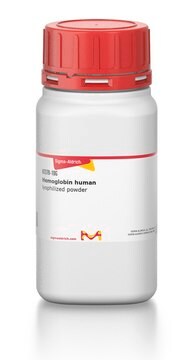L0288
Lipid Mixture 1, Chemically Defined
liquid, sterile-filtered, BioReagent, suitable for cell culture
Synonym(e):
lipid mixture
About This Item
Empfohlene Produkte
Sterilität
sterile-filtered
Produktlinie
BioReagent
Form
liquid
Methode(n)
cell culture | mammalian: suitable
Verunreinigungen
≤10 EU/mL endotoxin
Lagertemp.
2-8°C
Verwandte Kategorien
Allgemeine Beschreibung
Anwendung
- as a component of bovine serum albumin (BSA) containing Bracket-Oliphant (BO) medium for the resuspension of sperm pellet
- as a supplement in spheroid media for culturing primary human subcutaneous stromal vascular fraction cells
- to prepare a cell steatosis model for culturing of mouse and human hepatocytes
Sonstige Hinweise
The final product contains 10% ethanol by volume.
Ähnliches Produkt
Lagerklassenschlüssel
10 - Combustible liquids
WGK
WGK 1
Flammpunkt (°F)
Not applicable
Flammpunkt (°C)
Not applicable
Hier finden Sie alle aktuellen Versionen:
Besitzen Sie dieses Produkt bereits?
In der Dokumentenbibliothek finden Sie die Dokumentation zu den Produkten, die Sie kürzlich erworben haben.
Kunden haben sich ebenfalls angesehen
Artikel
Importance and uses of linolenic acid in serum-free eukaryotic, including hybridoma and Chinese Hamster Ovary (CHO) cell, cultures
How palmitic acid, other fatty acids and other cell culture components affect the performance of serum-free, protein-free cell culture systems used for biomanufacturing heterologous proteins including monoclonal antibodies.
Importance and uses of linoleic acid in serum-free eukaryotic, including hybridoma and Chinese Hamster Ovary (CHO) cell, cultures
How the unsaturated fatty acid, oleic acid and other cell culture components affect the performance of serum-free, protein-free cell culture systems used for biomanufacturing heterologous proteins including monoclonal antibodies.
Unser Team von Wissenschaftlern verfügt über Erfahrung in allen Forschungsbereichen einschließlich Life Science, Materialwissenschaften, chemischer Synthese, Chromatographie, Analytik und vielen mehr..
Setzen Sie sich mit dem technischen Dienst in Verbindung.











